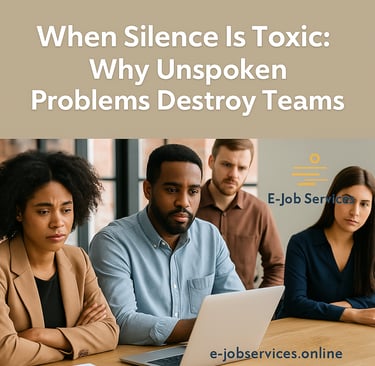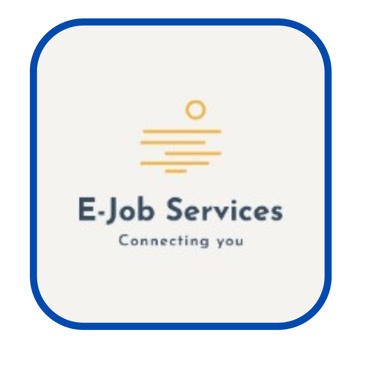When Silence Is Toxic: Why Unspoken Problems Destroy Teams
Silence can sink a team. This article reveals how unspoken problems damage trust, stall progress, and cost organizations dearly, plus practical tips to break the silence and build a speak-up culture.
WORK CULTURE, PRODUCTIVITY & MENTAL HEALTH
E-Job Services
8/12/20252 min read


Workplaces that look calm on the surface can be quietly collapsing from within. “Toxic silence”: the pattern of withholding concerns, questions, ideas, or bad news, drains teams of learning, innovation, and resilience. Left unchecked, it costs organizations in productivity, safety, turnover, and reputation.
The Real Cost of Keeping Quiet
When people don’t speak up, organizations miss early warning signs, small problems that could have been fixed before becoming crises. Gallup’s State of the Global Workplace report notes that global employee engagement is only about 21%, with low engagement costing the economy hundreds of billions in lost productivity annually. Low engagement and silence are often intertwined: disengaged employees are far less likely to raise problems or offer solutions.
Why People Stay Silent
Research by DecisionWise found that about one-third of employees avoid speaking up due to fear of retribution. Others stay silent because they believe nothing will change, they lack clear channels for feedback, or they work in cultures that prize deference over dialogue. Harvard Business School professor Amy Edmondson’s work on psychological safety shows that when employees feel unsafe to take interpersonal risks, silence becomes the norm.
Silence Undermines Learning, Innovation, and Safety
Teams that fear speaking up stop experimenting and sharing new ideas. Edmondson’s studies reveal that such teams learn less and perform worse over time. Case studies from Harvard Business Review highlight how silence has contributed to costly failures in industries from aviation to healthcare, all because early warning signals went unspoken.
Who Gets Silenced the Most
Toxic environments disproportionately silence women and marginalized groups, according to workplace inclusion research. This loss of diverse voices leads to blind spots in decision-making, further weakening the team’s problem-solving ability.
Signs of Toxic Silence in Your Team
Low participation in meetings, with only a few regular voices heard.
Problems reappearing instead of being resolved.
High turnover or signs of “quiet quitting.”
Common sentiments like “it’s not worth raising” or “nothing will change.”
How Leaders Can Break the Silence
Model Curiosity and Fallibility – Admit uncertainty, ask questions, and thank people for correcting you. (Edmondson’s research confirms this lowers the career risk of candor.)
Offer Multiple Safe Channels to Speak Up – Combine anonymous surveys with structured team discussions.
Respond and Follow Through – When employees see action after raising concerns, trust grows.
Train Managers in Inclusive Leadership – McKinsey research shows leadership development is key to psychological safety.
Measure Voice and Safety Regularly – Use pulse surveys to track whether people feel safe to speak up and whether past issues were addressed.
Quick Wins That Work
Begin meetings by inviting one “burning question” or concern.
Hold monthly “What worried you?” check-ins.
Publicly acknowledge employees who raised valuable improvements.
The Upside of Speaking Up
When employees have a voice, teams make better decisions, innovate more, and catch mistakes earlier. Gallup’s data make it clear: creating a culture where speaking up is safe is not just good for morale, it’s an economic advantage.
About E-Job Services
E-Job Services, a division of Global Caribbean Innovative Edge, helps organizations build healthy, high-performing workplaces and teams. We offer HR, recruitment, and people-development solutions, including culture diagnostics, leadership training, and practical strategies to strengthen communication and psychological safety. Our goal: help teams collaborate better and thrive.
References
Gallup. State of the Global Workplace Report. 2023.
DecisionWise. Employee Voice and Silence Study.
Edmondson, Amy. Psychological Safety and Learning Behavior in Work Teams.
Harvard Business Review. How a Culture of Silence Eats Away at Your Company.
McKinsey & Company. Psychological Safety and the Critical Role of Leadership Development.
